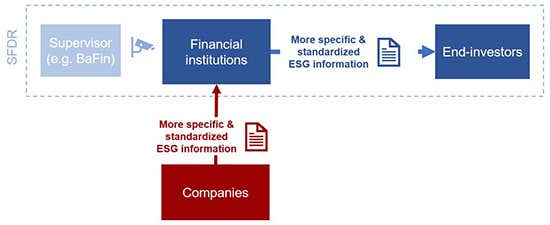Sustainable Finance Disclosure Regulation (SFDR): What to Expect
Sustainable Finance Series – The Company's Perspective
Sustainable Finance Disclosure Regulation (SFDR): What to Expect
Sustainable Finance Series – The Company's Perspective
Based on research provided by ECOFACT
As recently confirmed, the EU Sustainable Finance Disclosure Regulation (SFDR), becomes effective on 10 March 2021. The SFDR imposes sustainability-related disclosure requirements on financial services institutions such as banks, insurance companies, pension funds, and investment firms.[1] However, its implications go beyond the financial sector. This summary discusses how the SFDR will impact the real economy.
Until now, financial regulation has largely required financial institutions (in their capacity as capital providers to the real economy) to focus on the financial risks of their clients. Increasingly, it is demanding these capital providers look at businesses’ sustainability risks and opportunities, as these factors can also ultimately impact capital returns.
The EU adopted the SFDR in November 2019. This regulation is a step towards implementing the EU’s commitments under the UN 2030 Agenda, the corresponding UN Sustainable Development Goals and the Paris Agreement by, among other strategies, mobilizing capital flows towards environmentally and socially sustainable economic activities.
The SFDR aims to protect end investors by allowing them to make informed decisions about their investments. It does so by requiring financial sector institutions to be transparent about:
1. The integration of sustainability risks in their investment decision and advisory processes, including asset due diligence processes;
2. How they consider the adverse sustainability impacts of their investments (e.g., how the proceeds applied by investees, borrowers, and issuers have effects on environmental, social, and governance (ESG) matters); and
3. The sustainability of their financial products.[2]
These transparency obligations require the disclosure of information in the financial sector’s pre-contractual documents[3] and periodic reports, and on websites.
The SFDR addresses ESG issues throughout the investment cycle. On one hand, the SFDR looks at sustainability risks as ESG events or conditions that could cause a material impact on the value of an investment. On the other hand, the SFDR acknowledges that investment decisions may have principal adverse impacts (PAIs) on sustainability factors, i.e., environmental, social, and employee issues, respect for human rights, and anti-corruption and anti-bribery matters. Therefore, the SFDR encourages capital providers to consider sustainability risks alongside PAIs in all of their investment processes.
In this context, the SFDR recommends that financial institutions consider the due diligence guidance for responsible business conduct developed by the OECD and the UN‐supported Principles for Responsible Investment.
To ensure transparency regarding the sustainability of financial products, the SFDR creates two categories of ESG products:
(i) Products that have sustainable investments as an objective, which are subject to strict requirements under Article 2(17) SFDR. To summarize, an investment shall qualify as a “sustainable investment” if:
and
(ii) Products that promote environmental and/or social characteristics, which are seen as a catch-all category for sustainability-promoting products that do not meet all of the requirements under Article 2(17) SFDR.
Indexes and benchmarks, including the amended EU Climate Transition Benchmarks, the EU Paris-aligned Benchmarks, and sustainability-related disclosures for benchmarks as set out under the EU Benchmark Regulation (EU Regulation 2019/2089),[4] may be used to demonstrate how such financial products either promote environmental and/or social characteristics, or meet the sustainable investment objectives. On
July 17, 2020, the European Commission adopted new rules setting out minimum technical requirements for the methodology of EU climate benchmarks. The delegated acts were published in the Official Journal of the European Union on December 3, 2020 and entered into application on December 23, 2020.
In practice, the SFDR requires that Member States’ supervisory authorities verify whether financial institutions are providing “more specific and standardized” ESG information to end-investors. In order to do so, these financial institutions will need to obtain ESG information from companies in their capacities as investees, borrowers, and issuers.

While the last few years have already seen a dramatic shift in market appetite towards sustainability-minded companies, the forecasts see further mobilization during 2021. The SFDR is a key driver in this direction. Therefore, companies that are aligned with the SFDR’s requirements can become more attractive to capital providers and have a first-mover advantage (e.g., better costs of capital) in comparison to other less sustainability-minded or resource-constrained companies.
Initial steps that companies may consider to align with the SFDR and to anticipate the sustainability disclosure requirements of their capital providers include:
Particularly with respect to the last step, companies may take the following actions:
In February 2021, the Joint Committee of the European Supervisory Authorities published a final draft of regulatory technical standards (RTS) supplementing the SFDR. The Commission is expected to adopt them in May 2021. Once adopted, the RTS will come into force and give companies clarity about which sustainability indicators will be measured. Annex I of the final draft includes three tables with examples of environmental and social indicators.
Our next Sustainable Finance Series summary will review how EU Regulation 2020/852 on the sustainability taxonomy is expected to impact the real economy.
[1] The SFDR determines which financial institutions are covered by its scope under the definitions of “financial market participant” (defined in Article 2(1)) and “financial adviser” (defined in Article 2(11)).
[2] In terms of financial activities, the SFDR currently applies to financial products (defined in Article 2(12)), investment advice (defined in Article 2(16)), and insurance advice (defined in Article 2(21)). Although the SFDR does not currently mention loans, the European supervisory authorities have declared that similar requirements are expected to apply to these products.
[3] These may be prospectuses, key information documents, or others, as specified in Article 6(3) of the SFDR.
[4] Following the legislative process, Regulation (EU) 2019/2089 of the European Parliament and of the Council of November 27, 2019 amending Regulation (EU) 2016/1011 regarding EU climate transition benchmarks, EU Paris-aligned Benchmarks, and sustainability-related disclosures for benchmarks was published in the Official Journal of the European Union on December 9, 2019, and entered into effect on April 30, 2020.
Practices
Industries + Issues
Regions